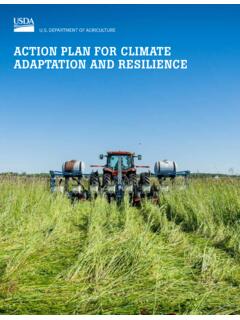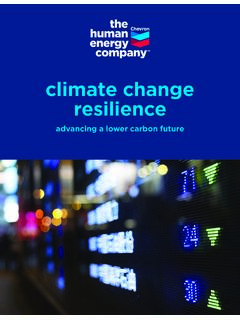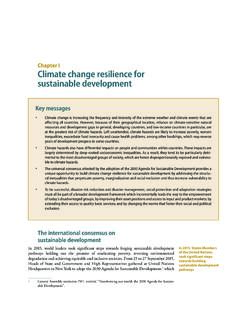Transcription of WHAT IS CLIMATE RESILIENCE AND WHY DOES IT MATTER?
1 INTRODUCTIONThe scientific evidence is overwhelming: The CLIMATE is changing, and human activity is the primary factor in the acceleration of CLIMATE change over the past century. Regardless of how successful humans are at limiting the root causes of our warming planet, society is facing significant impacts from more frequent and severe weather, ocean warming and acidification, extended periods of drought and extreme temperatures, and other deleterious effects of CLIMATE change. The ability to prepare for, recover from, and adapt to these impacts is called CLIMATE RESILIENCE . RESILIENCE is an increasingly common word in the CLIMATE change vernacular.
2 Extreme weather events have shown that RESILIENCE is an essential component of any comprehensive CLIMATE action program because CLIMATE change is both a global and a hyper-local issue. The causes and the broad impacts affect everyone on the planet, but RESILIENCE efforts must be executed at the as-set, neighborhood, or individual level. It will take a com-bined and coordinated effort, like none ever seen before, to address this issue. The good news is that addressing these risks can not only protect people and property, but also generate economic activity that will create domestic jobs and drive prosperity. WHAT IS RESILIENCE ?There are innumerable definitions of the term RESILIENCE , starting with its origin and then in the context of CLIMATE change.
3 According to the Oxford English Dictionary, 1 the first reference to RESILIENCE was by Francis Bacon in the 17th Century to describe the physical characteristics of an echo and how it bounces back off a wall. In the beginning, RESILIENCE literally meant to bounce back. Many people have redefined the term from Bacon s day, but one aspect has not changed: there must be something to bounce back from. Therefore, RESILIENCE is relative term, not an absolute one. One has to be resilient to something. It is important to first understand the threats and vulnerabilities of a particular event or phenomenon, and both the likelihood and consequence of these impacts.
4 When people live in a coastal area or on a low-lying island, sea level rise and tidal flooding may be their biggest concern it is important to be resilient to too much water. But in some plac-es like the western US and very acutely in Cape Town, South Africa, it s the opposite problem people need to be resilient to not enough water. The planning required to bounce back from impacts of CLIMATE change CLIMATE RESILIENCE requires that CLIMATE risks be more fully understood. WHAT IS CLIMATE RESILIENCE AND WHY DOES IT MATTER? CLIMATE ESSENTIALSA pril 2019 CLIMATEESSENTIALSThis special series of publications discusses CLIMATE change impacts across the economy, highlighting actions taken to build RESILIENCE and reduce for CLIMATE and Energy Solutions2A second issue of RESILIENCE relativity is that perspec-tive matters.
5 Individuals and institutions may care more about one risk or impact more than another, depending on how that vulnerability affects them directly. The risk of losing power for a short time, for example, may be less concerning in a temperate CLIMATE than if that power is needed to survive a heatwave. Likewise, if electrical medical equipment is routinely needed, the loss of power even for a short period of time can be very disruptive. If the power goes out for a few minutes while working on a laptop, the disruption is more an annoyance than really disruptive. If stuck in a hot elevator or on a subway train in a tunnel, the consequence of a short outage may be long-lasting and impactful.
6 If an individual can easily to recover from the event, they are typically considered to be resilient to that National Academy of Sciences defines RESILIENCE as, the ability to prepare and plan for, absorb, recover from, and more successfully adapt to adverse events. 2 Likewise, the current government definition states, RESILIENCE includes the ability to withstand and re-cover rapidly from deliberate attacks, accidents, natural disasters, as well as unconventional stresses, shocks, and threats to the economy and democratic system. 3 Many other organizations have defined RESILIENCE as specific to their mission and those definitions include things like the developmental RESILIENCE of children or of the sup-ply and value chains in the business world, what has not changed from Francis Bacon s day is that bouncing back is at the core of RESILIENCE .
7 The ability to bounce back is different for different people, based on their specific situation. For example, the decades-long financial crisis in Puerto Rico led to a level of infrastructure disrepair and physical and fiscal resource constraints (chronic stresses) that made it nearly impossible for the island to absorb or bounce back quickly from the devastating impacts of Hurricanes Irma and Maria (acute shocks) in 2017. In contrast, New York City was much better prepared to recover quickly from Hurricane Sandy in 2012 because its infrastructure sys-tems and organizations were better staffed and funded. There are many other issues that affected the difference in recovery between Puerto Rico and New York, but the institutional capacity of the public and private organiza-tions in each location, was a major factor.
8 Regardless of the specific definition used, understand-ing the risks and their context enables effective planning for RESILIENCE and this does not change whether looking at CLIMATE , terrorist, or other risks. THE RESILIENCE -RISK RELATIONSHIPM aking buildings, systems, and communities more resil-ient to shocks and stresses requires understanding the concept of risk and how to manage it. Risk is a function of two related concepts: threat and vulnerability. These three terms are frequently used interchangeably but they have precise and very different meanings. Threats are the actions that can negatively impact an asset or system and vulnerability is the degree of potential damage to the asset.
9 Risk, therefore, is function of threat multiplied by vulnerability as depicted in Figure 1. The likelihood of the threat and impact of the vulnerability are part of this equation. As well, the components of vulnerability sensitivity, exposure, and adaptive capacity are critical to assessing RESILIENCE . In this model, sensitivity is defined as the degree to which a system, population, or resource is or might be affected by hazards. Exposure means the presence of people, assets, and ecosystems in places where they could be adversely affected by hazards. And adaptive capacity is the ability of a person, asset, or system to adjust to a hazard, take advantage of new opportunities, or cope with change.
10 For example, the Fourth National CLIMATE Assess-ment predicts more frequent and severe weather due to CLIMATE This is a threat to houses and other structures located in a floodplain. The chance that it will rain is not affected by what is built, but the vulnerability of the house or facilities to flooding is affected by their design and construction. A house may be vulnerable to flood water because it was built at ground level. On the other hand, if the house is elevated and the only ele-ments at ground level are designed to get wet, the house is less vulnerable. The threat of flooding is still there, but the risk is much lower because the impact of flooding is less damaging.







